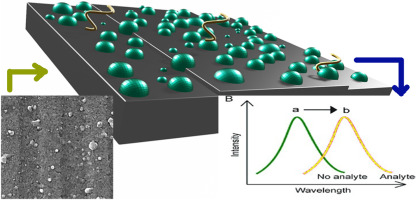 Abstract: Multiple applications can be developed and produced with the LSPR biosensor. For these, in addition to experimental investigation, detailed modeling and simulation are investigational priorities. This study utilizes an inexpensive microchannel substrate to produce the biosensor via thermal evaporation without annealing. In addition to the experimental study, advanced 3D modeling besides FDTD optical simulation is used to investigate sensor characteristics. Initially, the extinction spectrum of the observed and simulated samples is matched well. In addition, the bulk RI sensitivity of the sensor was calculated to be 125 nm/RIU by the simulation procedure. Moreover, by developing the proposed model for considering local RI sensitivity, the 40 nm/RIU was simulated for local sensitivity. Furthermore, the simulation of the near-field effect highlights the significance of the microchannel substrate, as it offers a greater variety of spatial interaction possibilities between the recognition agents and the hot spots. For the fabricated sensor, the LOD of 1.14 µg/mL was determined for sensing VB12 in water at concentrations between 0.25 and 4 µg/mL. Therefore, due to the introduction of strong modeling and simulation, simple and practical plasmonic biosensors can be better understood and, as a result, designed more appropriately. Abstract: Multiple applications can be developed and produced with the LSPR biosensor. For these, in addition to experimental investigation, detailed modeling and simulation are investigational priorities. This study utilizes an inexpensive microchannel substrate to produce the biosensor via thermal evaporation without annealing. In addition to the experimental study, advanced 3D modeling besides FDTD optical simulation is used to investigate sensor characteristics. Initially, the extinction spectrum of the observed and simulated samples is matched well. In addition, the bulk RI sensitivity of the sensor was calculated to be 125 nm/RIU by the simulation procedure. Moreover, by developing the proposed model for considering local RI sensitivity, the 40 nm/RIU was simulated for local sensitivity. Furthermore, the simulation of the near-field effect highlights the significance of the microchannel substrate, as it offers a greater variety of spatial interaction possibilities between the recognition agents and the hot spots. For the fabricated sensor, the LOD of 1.14 µg/mL was determined for sensing VB12 in water at concentrations between 0.25 and 4 µg/mL. Therefore, due to the introduction of strong modeling and simulation, simple and practical plasmonic biosensors can be better understood and, as a result, designed more appropriately. |